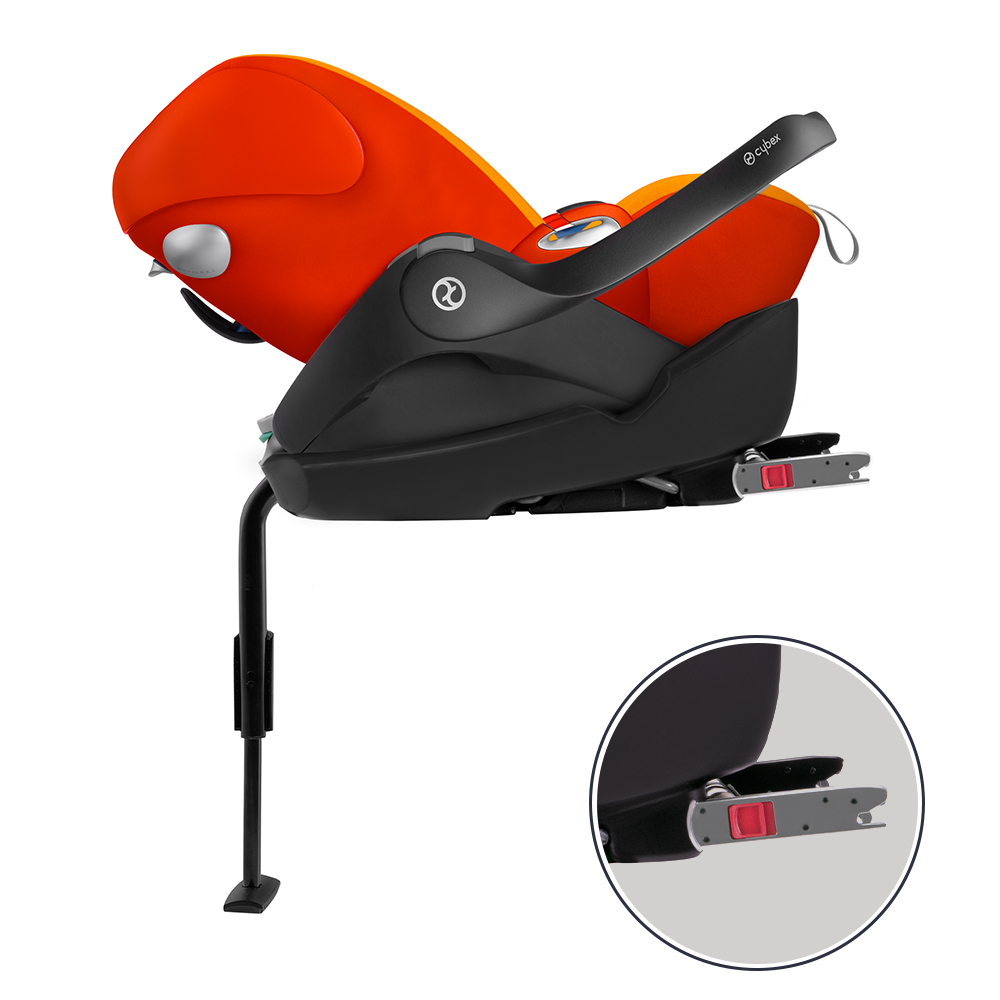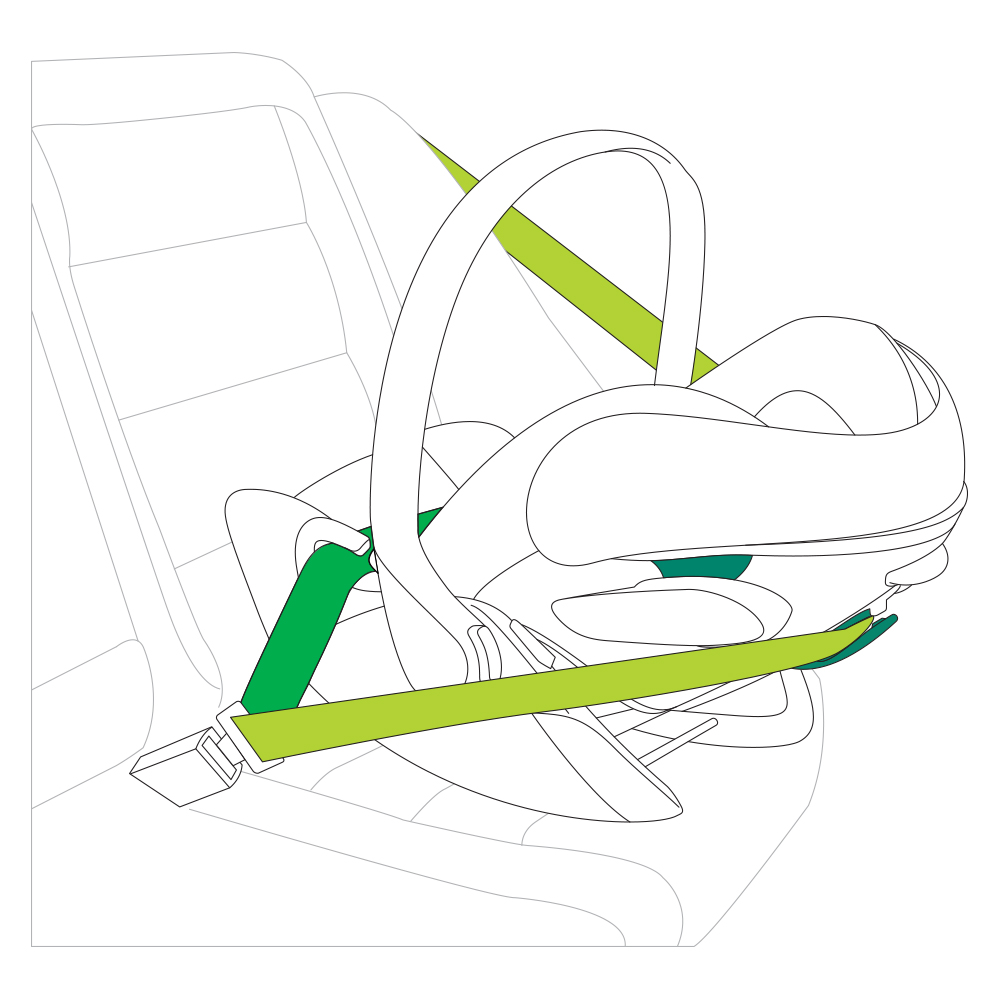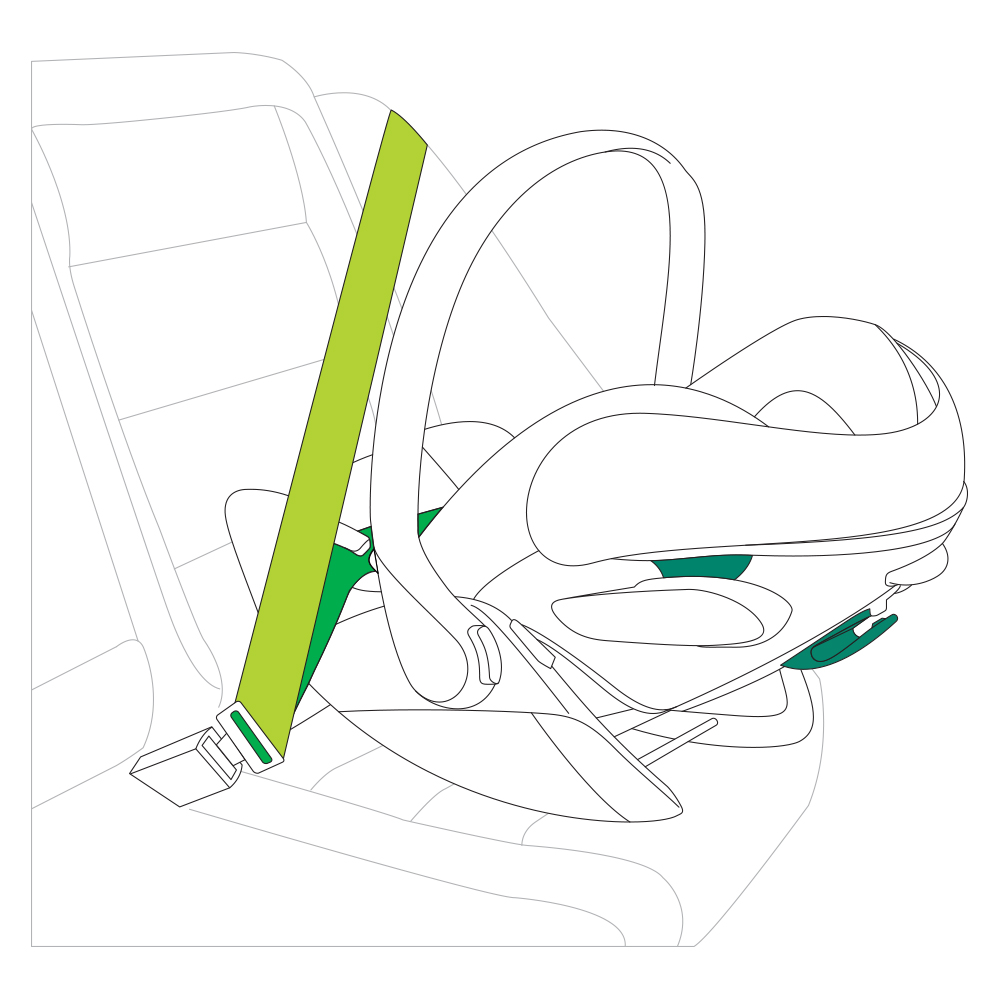
Frequently Asked Questions
Frequently Asked Questions
Frequently Asked Questions
Peace of Mind, Every Time
Every parent wants to make sure their child is safe – especially while you’re on the road. We're here to guide you through this topic and help you ensure the safest ride for your little one.
Car Seat Testing
Federal car seat safety standards require a frontal impact test with a 30-mph velocity change. This approximates the crash forces generated in a collision between a vehicle traveling 60 mph and a parked car of similar mass, or the energy produced in a fall from a three-story building. The National Highway Traffic Safety Administration announced a final rule in the summer of 2022 to add a side impact test protocol to the federal car seat safety standard. This rule goes into effect in August of 2025.
At CYBEX, car seat safety is a top priority. That's why we have created the CYBEX Side Impact test protocol. The CYBEX Side Impact test protocol was developed by CYBEX engineers using state-of-the-art facilities. The rigorous test simulates the energy in the severe 5-star government side impact tests conducted for automobiles.
CYBEX Side-impact testing simulates a crash in which the vehicle carrying the car seat is struck on the side by another vehicle. An example of a real-life side-impact collision is when a car crossing an intersection is struck on the side by another car that ran a stop sign.
All CYBEX car seats meet or exceed all applicable Federal safety standards and CYBEX’s side impact standards.
For car seat safety that you can depend on, trust CYBEX. Shop our collection of side impact tested car seats today.
Approximately one out of four vehicle crashes have a side impact component. According to the National Highway Traffic Safety Administration (NHTSA), impacts to the side of the vehicle rank almost equal to frontal crashes as a source of fatalities and serious injuries to children ages 0 to 12 years.
Car Seat Installation
When installing your car seat, the safest position in the car is ultimately one that you can achieve a proper and tight installation every time. If a proper installation is not possible in the center seat, the next best position is in the back seat behind the front passenger seat.
Please keep the following in mind when deciding where to install your car seat:
1. Never place a child in front of an active airbag. If there is no alternative, you must disable the airbag before installing the car seat.
2. Always check your car seat and vehicle user manual for guidance on the best place to install the seat, as well as any possible restrictions.
3. The use of lower anchors (LATCH) for the center seating position may not be approved by your vehicle manufacturer.
3. The use of lower anchors for the center seating position may not be approved by your vehicle manufacturer.
CYBEX allows specific car seats to be installed using the two inner Lower Anchors from the outboard seating positions if the distance between them is between 28-51 cm (11-20 in) AND if the vehicle manufacturer allows it. (If distance is not correct and/or not allowed by vehicle manufacturer, the vehicle belt must be used for installation in the center position.)
It’s always best to test the car seat in your vehicle before purchasing it. Ask your retailer if a test installation is possible.
If you’re not able to try out the car seat, you can check the car seat product dimensions provided by the manufacturer, and measure out the space in your vehicle.
Please note that comparing the dimensions of your car seat and your vehicle’s back seat will not always give you the full picture. There are many thousands of combinations of vehicle makes, models, car seat configurations, vehicle seat belt designs, and seat cushion shapes. Therefore, the surest way to determine whether your car seat is suitable for your vehicle is to test the car seat first and check whether a proper, tight installation is possible.
There are many thousands of combinations of vehicle makes, models, car seat configurations, vehicle seat belt designs, and seat cushion shapes. The easiest way to determine whether a particular car seat setup is suitable for your vehicle is to test it out first and check to make sure all car seats can be installed properly, especially when trying to fit multiple car seats on the back bench of your vehicle.
The following conditions should be met when installing three car seats next to each other:
- Each car seat must be installed firmly and correctly.
- Each car seat must be positioned properly on an individual vehicle seat and must align properly with the seat belt or lower anchors that secure them. None of the car seats should encroach onto another vehicle seat, and the position of each car seat must not be affected by contact with another seat.
- If the individual seats on the back bench can be adjusted forwards and back, make sure that all vehicle seats are adjusted to the same position.
- Only one lower anchor connector must be connected to any single lower anchor point.
- None of the car seats can come into contact with any surface in a way that could bend or deform any of their components.
- None of the lower anchor belts or seat belts used to install each car seat should rub on each other or crossover in such a way that they interfere with each other.
In addition to this, some car seats are designed to rotate to allow easy onboarding and offboarding, for example, the CYBEX Sirona S. These car seats need additional lateral space for the rotation, which may mean that so fitting another car seat in the adjacent seating position isn’t possible without restricting the use of this feature.
There are many thousands of combinations of vehicle makes, models, car seat configurations, vehicle seat belt designs, and seat cushion shapes. Therefore it’s not easy to say for certain whether a third passenger will fit on the back bench of your vehicle. For example, some smaller sedans and SUVs have rear seat belt systems that overlap, which makes it very difficult to fit a third passenger in the rear seat.
In addition to this, some car seats rotate to allow your child to be easily onboarded and offboarded, for example, the CYBEX Sirona S. This car seat will need some additional lateral space for the rotation, so fitting a passenger in the adjacent seating position may make using that feature difficult.
The easiest way to determine whether a particular car seat setup is possible is to test it out beforehand and ensure that the car seats can maintain a proper, tight installation, especially when trying to fit multiple passengers in the back seat of your vehicle.

Flexible LATCH is a system for attaching a car seat to the lower anchor bars in a vehicle. The anchor bars are positioned between the vehicle seat cushion and backrest. The car seat is attached to these bars with either hook-style or push-on lower anchor connectors, connected to the seat by straps.
When installing the car seat, each lower anchor connector must be attached to a lower anchor bar in the vehicle. Then the straps must be tightened until the car seat is secure.
Center Seat Installation: For CYBEX car seats with Flexible LATCH, it may be possible to use the center seating position if the following criteria are met:
1) This is permitted by the vehicle manufacturer.
2) The lower anchor bars are spaced 11 – 20 inches apart.

Rigid LATCH is a system for attaching a car seat to the lower anchor bars in a vehicle. This system uses rigid connectors on the car seat, designed to directly couple the car seat to the vehicle.
For car seat installation, the lower anchor connector system is attached to the lower anchor bars in the vehicle. Often the car seat is then pushed closer to the vehicle seat backrest to secure the installation. No tightening is necessary.
Center Seat Installation: On car seats with Rigid LATCH it may not be possible to install in the center seating position. You must use a seating position in the vehicle where the lower anchor bars are spaced 11 inches apart.

The European belt path is generally the preferred installation method for an infant car seat without a base. This method requires a seat belt system with both a lap and shoulder belt.
The lap belt is placed across the infant car seat, running through belt guides on top of the seat. The shoulder belt is run through a belt guide at the back of the seat.
The key benefit of the European belt path is that the shoulder belt provides additional stability and helps to limit rotation in a frontal crash.
Note: In some vehicles, the lap/shoulder belt system may not be long enough to stretch around the infant car seat. If this is the case, you can use the standard belt path installation method.

The standard belt path method is for the lap belt to be stretched across the infant car seat and placed in belt guides on top of it.
The shoulder belt is left to lie across the vehicle seat backrest. Only the lap belt is secured in the belt guides on the car seat.
Car Seat Safety
Some car seat harnesses are adjusted by pulling a strap at the front of the car seat (between the child’s legs). These generally adjust more smoothly when pulled in a downward motion. However, if the car seat is installed in a rear-facing position it can be harder to pull downward on the strap. In this event, try the following:
1. Place your child in the seat and buckle the harness.
2. Pull the chest clip out towards you. This will tighten the harness across the child’s legs and gather all of the slack at the child’s shoulders.
3. Next, pull the strap between the child’s legs to remove the slack. Make sure the chest clip does not slide up into the child’s face.
4. Position the chest clip at armpit level and check the harness for tightness by pinching at the child’s shoulders.
CYBEX car seats come with positioning inserts, which should be used per the instructions in your car seat user guide. Using the insert that came with your car seat may help eliminate the gap between your child and the buckle.
If the positioning insert does not eliminate the gap, you may use some fabric such as a small washcloth to help fill in this gap. Simply place your child in the car seat and buckle and tighten the harness until it is tight enough so you cannot pinch the straps together at the child’s shoulders. Once tightened, slide the cloth in the gap between your child and the crotch buckle.
If needed, you may also use tightly rolled receiving blankets placed next to your child to center him or her in the car seat. The positioning blankets should never be placed under the child, between the child and the harness, or near the child’s mouth, face or neck.
Belt-positioning booster seats are designed to raise the child up and help to position the vehicle lap and shoulder belt correctly. When a child is properly positioned in a belt-positioning booster seat the vehicle’s restraint system can correctly secure them, reducing their risk of injury in all types of crashes. In the event of a crash, the vehicle seat belt system provides all of the crash protection for a child in a belt-positioning booster seat. Because a seat belt extender modifies the existing vehicle seat belt system, it should be specifically approved for use by the vehicle manufacturer before use with a booster seat.
First, consider whether your child should be moved back to a rear-facing car seat, as these often provide a more reclined position and may help prevent your child’s head from falling forward. The American Academy of Pediatrics recommends that children remain rear-facing until they meet the upper height and weight limits of their rear-facing car seat.
If you decide to keep your child forward-facing, check to see if his or her car seat has a recline feature, as this may help keep your child’s head in the headrest. Many forward-facing car seats offer a mechanism providing a semi-recline for installation. Be sure to check your user guide for weight restrictions and to ensure you use this feature properly. Additionally, many CYBEX car seats and booster seat models feature a three-position reclining headrest which allows the child to sit with his or her head tilted back, helping it stay in the protected area of the seat.
Finally, if allowed by the vehicle manufacturer, the vehicle seat can be slightly reclined when installing the car seat. Reclining the vehicle seat may also help keep your child’s head resting in the restraint. Please always follow the installation instructions of both the vehicle and car seat manufacturer, and ensure that installation is carried out correctly and securely.
General Questions
Every car seat comes with a postage-paid product registration card in the box. It is important that you take a few minutes to complete this card and place it in the mail. Or you can visit our website to complete this information. These details allow us to contact you in the unlikely event of a product recall.
All CYBEX car seats have an expiration date. The period of use is indicated on a label on the product and noted in the product instructions. This timeframe ranges from six years to ten years depending on the type and function of the car seat. Safety standards change over time as restraint technology develops.
As soon as a car seat is installed in a vehicle, it may be exposed to high temperatures and high levels of light intensity. As a result, even high-quality and extremely age-resistant plastics such as those used by CYBEX can display certain age-related alterations. To ensure the safety of your child, we strongly recommend that the seats are not used for longer than the prescribed usage periods.
Expiration dates also help ensure that you are not using a car seat that may be second-hand, has been in a crash, or has missing or damaged parts. Also, an expiration date provides a gentle reminder that it is time to buy a new seat with the latest technology and safety features.
Car seats should always be cleaned according to the instructions provided with the car seat. In general, the fabric parts of a CYBEX car seat may be removed and machine washed separately in cold water on a delicate cycle with mild detergent. This includes the seat cover, body and head inserts, shoulder pads, and buckle pads (if present). These items must drip dry. You can also spot clean these items, as well as the harness straps, using a clean cloth with mild detergent and water.
Only accessories provided or approved by CYBEX should be used with CYBEX car seats. This includes newborn inlays, harness covers, seat protectors, and so on. The use of accessories or parts from other manufacturers could alter the performance of the child restraint.

